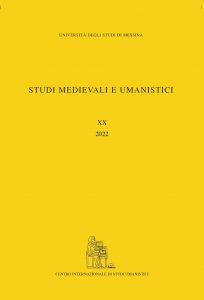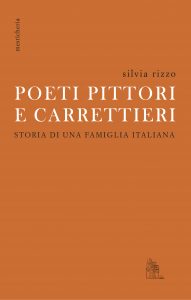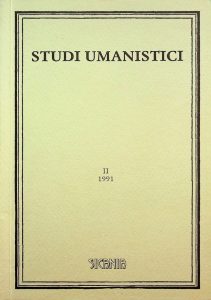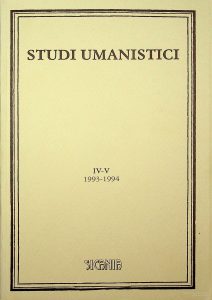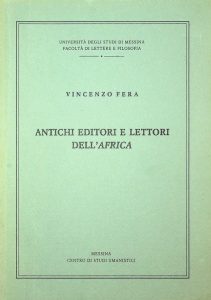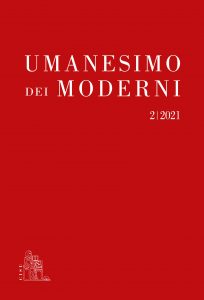
2 | 2021
Messina, Centro Internazionale di Studi Umanistici, 2020, 320 pp.; 25 cm.
ISSN 2724-0835
ISBN 978-88-87541-84-7
€ 70
INDICE GENERALE
Vincenzo Fera, Edizioni in cerca d’identità
Giovanni Barberi Squarotti, «Con la coscienza di compiere un dovere»: i Poemi del Risorgimento nell’edizione di Maria Pascoli (1913)
Massimo Castoldi, Giovanni Pascoli: varianti d’oltre tomba
Giorgio Forni, Maria editrice di Giovanni. Qualche caso dantesco e il Piccolo Vangelo
Luca Verrelli, Per l’edizione delle prose pascoliane: i Discorsi
Annarita Zazzaroni, Pubblicare i testi teatrali: Gretchen’s Tochter – La figlia di Ghita
Caterina Malta, «Un complesso sistema d’edifici, lasciato a mezzo». Qualche interrogativo editoriale sui Carmina
Xavier Van Binnebeke, Un poeta moderno ad Amsterdam: Pascoli e il Certamen Hoeufftianum. I. Da Leucothoe a Pecudes
Francesco Galatà, Maria Pascoli e le carte giovanili del fratello
Daniela Gionta, Verso un corpus delle epigrafi pascoliane
Indice dei manoscritti e delle fonti d’archivio
Indice dei nomi
ABSTRACT
VINCENZO FERA, Edizioni in cerca d’identità
The article focuses on the texts by Giovanni Pascoli, which were published by his sister Maria after his death (April 1912), identifying the reasons and objectives of the artistic and editorial choices and highlighting the critical aspects of the metho- dology adopted in the preparation of the editions.
GIOVANNI BARBERI SQUAROTTI, «Con la coscienza di compiere un dovere»: i Poemi del Risorgimento nell’edizione di Maria Pascoli (1913)
The posthumous edition of Giovanni Pascoli’s Poems of the Risorgimento(1913) is based on mostly unfinished and largely provisional texts, on which his sister Maria proceeded with the aim of providing an overall organic and complete work both on a structural and on a textual level. The article summarizes the status quaestionis on the basis of the manuscript testimonies and reconstructs the editorial interventions by Maria, who acted as the interpreter of an author’s will that was never fully or defi- nitively expressed.
MASSIMO CASTOLDI, Giovanni Pascoli: varianti d’oltre tomba
The posthumous publishing history of Giovanni Pascoli’s Canzone del Carroccio and Canzone dell’Olifante confirms that, even after the author’s death, variants or redactions of texts attributable to him may have reached the printer. These, which I have called ‘variants from the afterlife’, may be due either to the annotations left for the printer or to working copies revised and corrected by the author and then used by others to review the texts. The copy of Canzone dell’Olifante is preserved in the Castelvecchio Library. The confirmed existence of these ‘variants from the afterlife’ forces us to reconsider the entire posthumous printed tradition of the other works published at a reasonable, but undefinable, time after the author’s death as well. Investigations in this sense lead to significant results, especially for the Dante-related essay Sotto il velame, but must be extended to all works.
GIORGIO FORNI, Maria editrice di Giovanni. Qualche caso dantesco e il Piccolo Vangelo
All of Maria Pascoli’s activity as her brother Giovanni’s posthumous publisher appears dominated by a sense of a prematurely interrupted work and by a desire to preserve it and almost to continue it, in such a way as to make up for the heart- break. By examining the re-editions of Minerva oscuraand Sotto il velame and the editorial history of the Piccolo Vangelo, the essay offers significant examples of the editorial work carried out by Maria, who proved to be attentive to the auto- graph testimonies from her brother’s writing desk, yet willing to undertake an exer- cise in inlaying heterogeneous fragments in order to make what was still sketchy and provisional fully accomplished.
LUCA VERRELLI, Per l’edizione delle prose pascoliane: i Discorsi
This article studies the philological methodologies and some textual issues regarding Giovanni Pascoli’s published discourses. In particular the essay analyzes the transi- tion of these texts from extemporaneous publication (e.g. on newspapers), to pam- phlet editions and ultimately to collections of essays in volume. This analysis starts necessarily with the making of Pensieri e discorsi, but the point of view immediate- ly broadens to Pascoli’s other essays, in particular those collected in the posthumous editions. In the final section the study deals with Pascoli as a reviewer and proof- reader of his own prose; it analyzes a series of errors and misprints that were never corrected and remained in the posthumous editions of Pascoli’s discourses.
ANNARITA ZAZZARONI, Pubblicare i testi teatrali: Gretchen’s Tochter – La figlia di Ghita
The libretto Gretchen’s Tochter – La figlia di Ghita by Pascoli is an example of a posthumous edition by Maria Pascoli. After a philological history of the text, the article illustrates the criteria of the edition of this and others Pascoli’s librettos by Maria. Also, through two case studies, some hypotheses are advanced in order to restore the documentary facts.
CATERINA MALTA, «Un complesso sistema d’edifici, lasciato a mezzo». Qualche interrogativo editoriale sui Carmina
The contribution focuses on the philological problem of the occasional compositions included in the collection Poematia et epigrammata. In particular, it discusses the issue of ode XXXIV, which accompanied the gift of the poem Veianius to Pope Leo X. Pascoli reused the ode with slight changes as a dedication to his Livornese friend Pietro Micheli. The compositional process of the text and the historical-cultural background of the double destination are clarified.
XAVIER BINNEBEKE, Un poeta moderno ad Amsterdam: Pascoli e il Certamen Hoeufftianum. I. Da Leucothoe a Pecudes
The recuperation in 2012 in Haarlem and Castelvecchio of the original Latin poems submitted by Giovanni Pascoli to the Certamen Hoeufftianum has favored a new approach to the transmission history of Pascoli’s Latin oeuvre. Fundamental to this approach is the analysis of the reading notes and judgments that were made by the Dutch Certamen committee. In this contribution the poet’s Certamen poetry from Leucothoe (1884) to Pecudes (1899) is lined up. We will facilitate access to the ori- ginal manuscripts and extant reading notes, and provide in Italian translations of the Dutch verdicts of Pascoli’s submissions. A future instalment will treat the re- maining poems up to Thallusa (1912).
FRANCESCO GALATA’, Maria Pascoli e le carte giovanili del fratello
The essay reconstructs the history of some of Giovanni Pascoli’s youthful papers now preserved in the poet’s Archives in Castelvecchio: the famous ‘notebook of Father Cei’, containing Pascoli’s first poetic attempts in Italian and Latin; the so- called ‘Schinetti papers’; the exam papers compiled in 1880 for a study grant pro- vided by the Municipality of Bologna (the test of Italian literature On Italian prose in the 19th centuryis for the first time published in the Appendix).
DANIELA GIONTA, Verso un corpus delle epigrafi pascoliane
This essay offers a preliminary critical reflection to prepare the ground for publica- tion of Pascoli’s epigraphic corpus. Of the cases that follow, some constitute new epigraphic ‘tiles’ unknown to the studies on Pascoli, others are to be reconsidered in the light of new evidence. On the whole, they offer a first sampling of the critical problems that characterize the approach to such peculiar and too often understated production of the poet.

